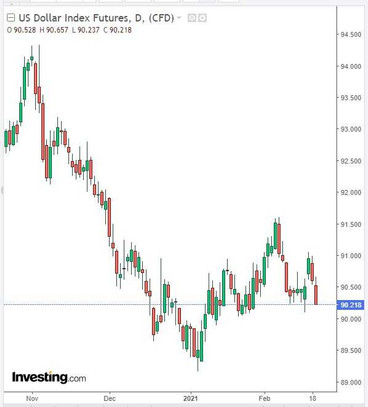Despite the more moderate than expected growth in retail sales in Australia, data on which were published at the beginning of today's Asian session, the Australian dollar strengthened during today's Asian session and early European session. According to preliminary data from the Australian Bureau of Statistics, retail sales (this index is often considered an indicator of consumer confidence and reflects the state of the retail sector in the near future) in Australia increased by +0.6% in January (against the forecast of +2.0% and the previous value of -4.1%).
Despite this, investors focused on other positive macro data for Australia, published earlier. Thus, the preliminary composite purchasing managers index (PMI) of Australia (from IHS Markit), published at the beginning of today's trading day, amounted to 54.4 in February (against 55.9 in January), which indicates a continuing acceleration of business activity in the country's private sector in early 2021 (a result above 50 is seen as positive and strengthens the AUD, below 50 as negative for the Australian dollar).
Other macro data suggests that the Australian economy is creating jobs at the fastest pace since the end of 2018, and inflationary pressures are mounting. Thus, purchase prices have grown since the beginning of this year at the fastest pace in about five years; growth in selling prices also accelerated.
Last Thursday, the Australian Bureau of Statistics published a pretty decent report on the country's labor market. According to the data presented, employment in January increased by +29100, and the unemployment rate dropped to 6.4% (against the forecast of 6.5% and the previous value of 6.6%). The report reflected the continued growth in employment and the improvement in the country's labor market. The good pace of new job creation was not only a reaction to the stable growth of new orders, but also a sign of greater confidence of representatives of national business in the prospects of the country's economy.
Other factors contributing to the AUD's strength are rising oil prices, as well as coal, LPG and copper, which are among Australia's top exports. Thus, copper rose in price on the commodity market to highs in eight years.
Rising global stock indices also support market sentiment and interest in buying commodity currencies, in particular the Australian dollar. Many market participants remain optimistic given the successes of vaccinations and anticipating the imminent adoption of additional fiscal stimulus measures, which should spur economic growth and the resumption of normal functioning of sectors of the economy seriously affected by the pandemic.
Despite a number of signals from the Reserve Bank of Australia that low interest rates will remain in force for many years, and the central bank will do everything necessary to stabilize its currency, judging by the minutes of the February RBA meeting published last Tuesday, the Australian dollar has a tendency to further rise, including in the pair AUD / USD, which is traded at the beginning of today's European session near 0.7840 mark, renewing a 3-year high.
Today, market participants will analyze data on business activity and sales in the US secondary housing market, the publication of which is scheduled for 14:45 and 15:00 (GMT). Business activity in the US is expected to continue to accelerate in February, despite a slight relative decline in PMI indices (indicators above 50 indicate an acceleration in business activity, albeit at a slower pace). The US dollar fell on Thursday and during today's Asian session due to conflicting statistics released yesterday. Thus, the number of initial applications for unemployment benefits rose to 861 thousand against the forecast of 765 thousand, and the previous value was revised from 793 thousand to 848 thousand. The US dollar is also negatively affected by the growing stock market, as well as real inflation in the United States and the increasing national debt and federal budget deficit.






